Equal parts social media platform and search engine, Pinterest had over 431 million active monthly users in early 2022. But the popularity of the platform means it's a crowded space, and the task of getting followers on Pinterest can feel daunting.
Fortunately, there are tactics you can implement right now to increase your real follower count on Pinterest to increase web traffic, drive sales, and help your grand gain authority.
Here, we're going to dive into everything you need to know to grow your Pinterest audience today.
How to Get More Followers on Pinterest
- Use a Pinterest business account.
- Optimize your username and Pinterest bio.
- Post Idea Pins.
- Include text on your Idea Pins.
- Focus on a specific audience.
- Post original images.
- Include relevant topic tags to increase video reach.
- Create a cohesive brand for recognition on the platform.
- Post infographics to promote proprietary data for your company.
- Use keywords in your board names and pin descriptions.
- Include relevant keywords in your Pinterest name, too.
- Use Pinterest Trends to plan your content.
- Share new content weekly.
- Be active and engaged on Pinterest.
- Follow other users.
- Add a Pinterest follow button to your newsletter or website.
- Use Pinterest sections to organize your boards.
- Promote your pins.
- A/B test your pins to see what works.
- Use Pinterest's free shopping tools.
- Join the verified merchant program.
- Apply for Rich Pins.
- Re-pin older content.
- Claim your website on Pinterest.
- Schedule your pins.
1. Use a Pinterest business account.
On Pinterest, business accounts have access to tools such as unique content formats, advanced analytics, shopping features, and the ability to create an ad account to promote your content.
When creating a new account, you can opt to turn it into a business account during the setup process. If you have an existing account, you can convert it to a business account to maintain authority.
2. Optimize your username and Pinterest bio.
Your username and bio are completely searchable. Make sure you include search terms related to your niche that your customers may be looking for on Pinterest to increase profile visibility.
For example, content creator Chelsea Clark added the keyword "plant-based wellness" to her Pinterest profile, making her content more likely to show up for users who include the term "plant-based" in their Pinterest search.
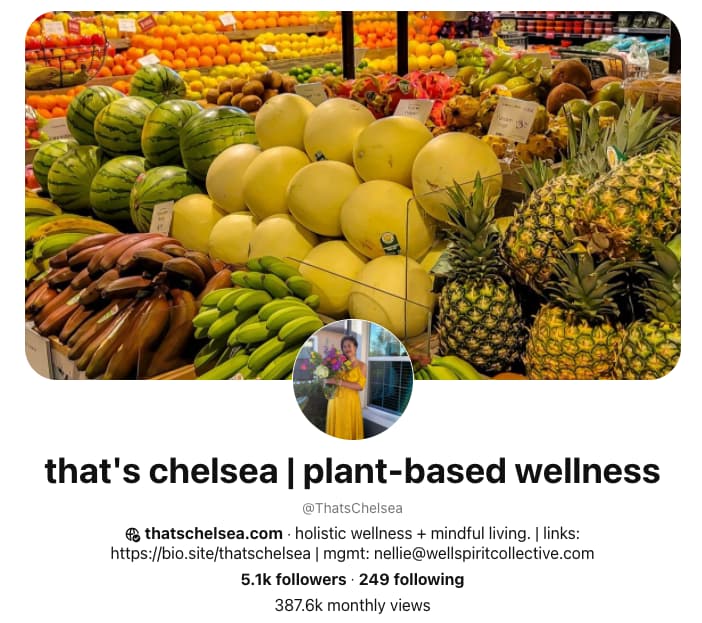
3. Post Idea Pins.
Idea Pins are a multi-page video-based format that Pinterest rolled out globally in 2021. The beta version of this feature rolled out in 2020 and was called Story Pins, and was initially used similarly to Instagram Stories.
Now, the Idea Pin feature allows creators and businesses to record, edit, and share up to 20 pages of content within one post. Notable Idea Pin features include the ability to record voiceovers, add transitions, tag other accounts, and add music.
Because Idea Pins don't expire after 24 hours like story features on other social media platforms, creators can use the feature to grow their reach and engagement.
4. Include text on your Idea Pins.
Once you get the hang of creating Idea Pins, try including text overlays to make your content more accessible, and easy to understand. Text on Idea Pins is also searchable within Pinterest, so make sure you include keywords potential followers are searching for.
5. Focus on a specific audience.
Even if your products or services could, in theory, be purchased by anyone, you should laser focus your Pinterest marketing strategy. You'll find that as you narrow your target, the better you'll be able to create content that actually resonates with them. By identifying a niche and dominating it, you can expand your reach as your content is consumed, shared, and recognized.
Creating a buyer persona is the first step to defining your audience, humanizing them, and understanding their needs.
6. Post original images.
84% of Pinners use Pinterest to decide what to buy — which means it's critical you position yourself in front of them by creating original content for your brand. Try posting original infographics, graphics, or photos that reflect your brand's message. Additionally, when you do re-pin, make sure you're re-pinning content that aligns well with your own brand.
7. Include relevant topic tags to increase video reach.
Pinterest is no longer encouraging the use of hashtags and instead recommends creators use topic tags to categorize their content and improve reach. Here's how you can use the topic tag feature:
8. Create a cohesive brand for recognition on the platform.
People do business with those they like, know, and trust, so the goal is to go from a stranger in your prospects' eyes to being known and trusted. On Pinterest, that means increasing the number of impressions your content earns from your target audience. An "impression" refers to any time a prospect "sees" you or your brand. If you don't have a consistent look and feel, your content won't be recognized as being related, which means you never build that trust.
According to Forbes, color improves brand recognition by up to 80%, and consistent brand presentation across platforms increases revenue by up to 23%. The big takeaway is that a consistent (and recognizable) brand identity is paramount to increasing ROI for your Pinterest marketing efforts. By building a brand identity, your target audience will start to recognize you in the niche, which is the first step to building trust.
9. Post infographics to promote proprietary data for your company.
Infographics are a perfect mix of data, visual, and written content, making them extremely shareable. For this reason, 40% of marketers reported that infographics were the type of visual content that helped them reach their marketing goals in 2021 according to Venngage.
Infographics do well on Pinterest, particularly, as it's a visual platform with the capability of displaying long, vertical images. By creating a custom-branded infographic and sharing it on Pinterest, you're establishing credibility by educating your audience. It also gives another opportunity for "impressions" to increase your brand recognition if the infographic is branded properly.
10. Use keywords in your board names and pin descriptions.
Pinterest users typically find brands through hashtags and searches, so it's important you include both in your descriptions and images.
When writing your pin description, it's critical you remain specific and descriptive. This ensures the highest chance that your pin will match a user's true search intent. For instance, let's say you have a pin for healthy dinner recipes. You're more likely to have users find and engage with your pin if it's saved to a board titled "Healthy Recipes" (which is what they are likely searching for) than something vague like "Healthy."
11. Include relevant keywords in your Pinterest name, too.
Pinterest marketing doesn't just come down to the shareability of individual posts but also discoverability. You'll want to position your brand in front of Pinterest users who are actually searching for your content. By including a couple of relevant keywords into your Pinterest name, your account is more likely to show up for interested searchers.
12. Use Pinterest Trends to plan your content.
Those using Pinterest business accounts have access to a tool called Pinterest Trends, which shows which keywords and topics are trending across various niche areas. Use the trends tool to find what your potential customers are searching for and let these results inform what content you share.
Pinterest also creates an annual report called Pinterest Predicts, which outlines which topics will likely trend on Pinterest for the upcoming year based on search patterns and unique data.
13. Share new content weekly.
According to Pinterest, the recommended posting cadence is at least one original pin per week. To get the most out of your Pinterest traffic, make sure your pins lead back to your website (or that you're linking your Idea Pins to your products).
14. Be active and engaged on Pinterest.
Like any social media site, Pinterest favors active accounts. This includes ensuring you pin on a regular basis, manually pin others' pins, and follow other boards. If you have trouble keeping up with your Pinterest activity, create a social media calendar to have a more focused and organized publishing strategy. You can also try using a tool like Tailwind, which allows you to schedule your Pinterest pins ahead of time.
It's vital you re-pin often. Consider going to the "Explore" and "Trending" pages and re-pinning from there. The more you re-pin and engage with other boards, the more likely you are to increase your reach.
15. Follow other users.
If someone is following a business with similar content to yours, chances are they'd be a good follower for you as well. Take some time to research competitors' and follow their followers — if your content is up-to-par, they'll more than likely follow you back.
Alternatively, perhaps there are businesses with products or services that work well in conjunction with your own. For instance, let's say you're an interior designer, and you find a company that sells handmade furniture on Pinterest. You might follow some of their followers since their followers are likely interested in either decorating or sprucing up their home.
16. Add a Pinterest follow button to your newsletter or website.
You can likely increase traffic to your Pinterest account if you embed a Pinterest follow button in an email newsletter or on your website. Since traffic to your site, or subscribers to your newsletter, are probably already interested in your product or services, they're a strong audience to target.
Plus, depending on where they are in their buyer's journey, your Pinterest account might actually help them decide whether your business is the right fit for them.
17. Use Pinterest sections to organize your boards.
Pinterest sections are similar to H2 sections of your blog posts — they enable you to organize your full Pinterest board into categories, so users can more easily find exactly what they're looking for.
For instance, take a look at Twins Mommy Blog's board:
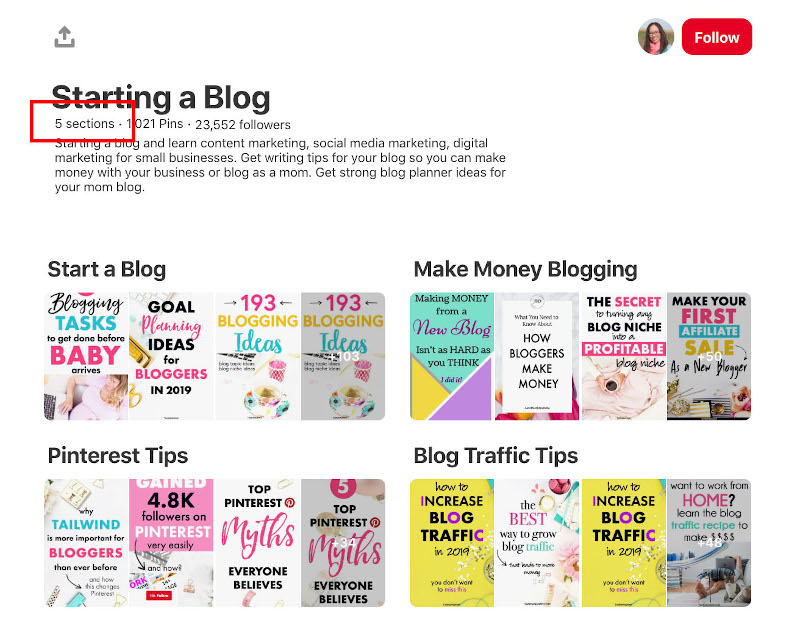
Sections, then, make your individual content more likely to be found and re-pinned.
18. Promote your pins.
If you have a business account on Pinterest, you could consider putting money behind a pin to increase visibility and reach — similar to paying for an ad on Facebook.
For instance, take a look at what I see when I type "travel" into Pinterest:
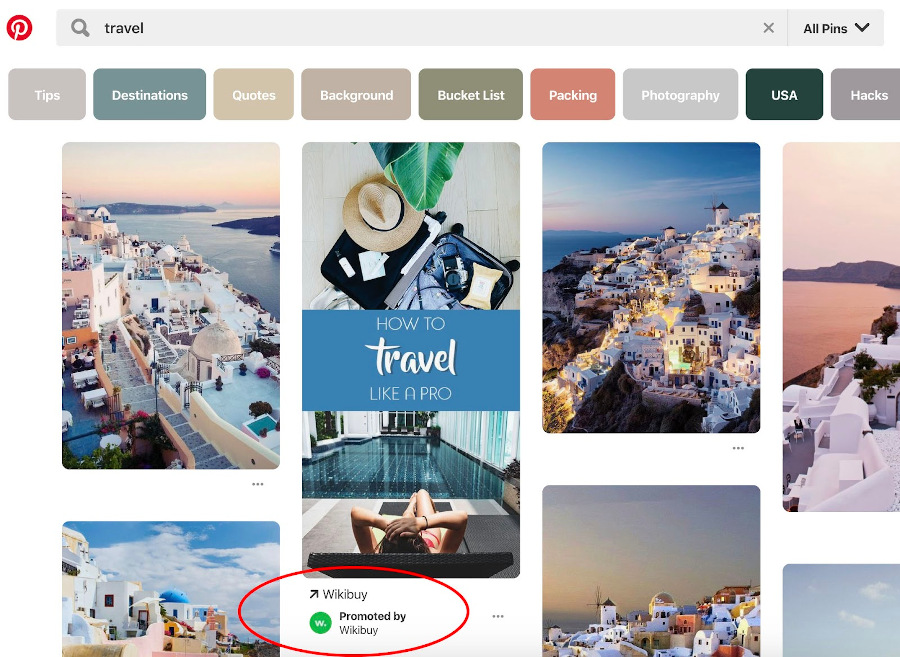
For increased visibility and reach, then, why not?
19. A/B test your pins to see what works.
You don't have to throw spaghetti against the wall to see what sticks. By testing different variables with your audience, you can continually improve your campaigns as you learn more about what resonates with them.
Here are some different variables to compare on Pinterest:
- Alternate headlines for your pin title
- Alternate thumbnail images for your pin
- Alternate post copy for your pin's description
Just be sure to only test one variable at a time. Set a time period to run the test, and then compare each post's performance using Pinterest analytics. Just make sure your A/B test's results are statistically significant before you make any decisions on future runs.
20. Use Pinterest's free shopping tools.
If you're looking to drive traffic to specific products, you can create Product Pins that have additional metadata to make them even more searchable which increases your chances of being found by users on the platform.
21. Join the verified merchant program.
Increase your company's credibility by becoming a verified merchant on Pinterest. Accounts that are a part of the program receive a coveted verified check mark confirming the account has been vetted by Pinterest, have products show up under related search terms, can activate a profile "shop" tab, and are able to access unique insights to see conversion data.
22. Apply for Rich Pins.
If you anticipate users pinning content directly from your website, you may want to consider applying for Rich Pins.
Rich pins automatically pull in key data from your website when Pinterest Pins are created, and allow existing pins to remain up-to-date with what's listed on your website. There are three types of rich pins:
- Product Rich Pins pull accurate inventory and product availability information from your website.
- Recipe Rich Pins which include a recipe name, list of ingredients, and pertinent cooking information pulled from blog posts that feature recipes.
- Article Rich Pins that include the title of an article, meta description, and author information.
Rich Pins are free to use. To get started, add the necessary meta tags provided by Pinterest to your website, then submit an application.
23. Re-pin older content.
Pinterest Pins have a lifespan of about four months, which is significantly longer than other social media platforms such as the 15-minute span of a tweet, or the 48-hour span of an Instagram post.
With this in mind, don't be afraid to pin older content to new boards to continue its lifespan even further and engage with a whole new audience.
If you do decide to create pins from older content, make sure you refresh the images for better engagement.
24. Claim your website on Pinterest.
If you haven't already, make sure your company's website is claimed by the official Pinterest account. According to Tailwind, 80% of Pinterest accounts with high engagement have claimed their websites on Pinterest.
In the image below, you can see the publication The Good Trade has claimed its website with the globe and checkmark symbol next to the company's URL.
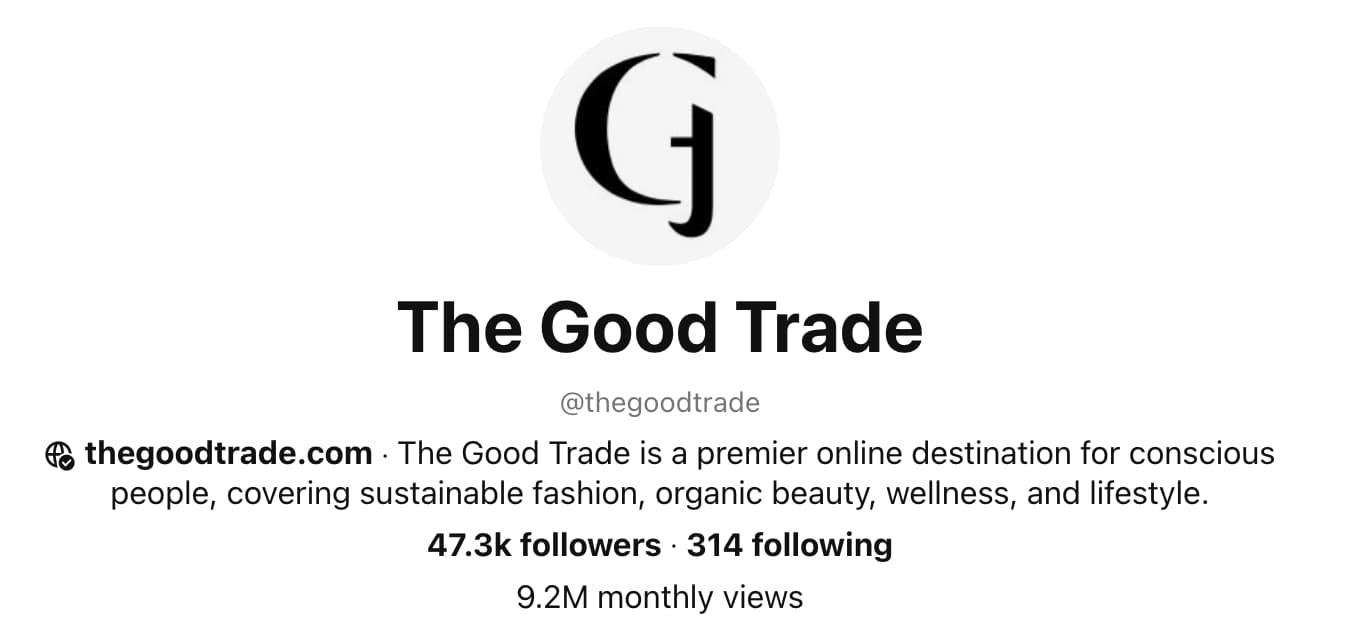
25. Schedule your pins.
Like most social media platforms, the key to success on Pinterest is consistency. To make sharing to Pinterest simple and easy, consider scheduling your pins in advance so they can go live when your audience is most likely to engage.
You can use popular software such as Tailwind to schedule your pins or use the scheduling tool within the Pinterest platform.
Reasons to Avoid Buying Pinterest Followers
Sure, there are tools you can use to buy Pinterest followers but this method is not in your best interest.
Buying Pinterest followers essentially means you're buying fake accounts to increase the number of followers you have, which will make it look like your business is popular on Pinterest. This can be tempting — why do the hard work of cultivating a following, when you can pay less than $20 for 1,000 followers, instantly?
Unfortunately, buying followers does more harm than good. Here's why.
1. It's against Pinterest guidelines.
In fact, your company could be banned from the site if Pinterest figures out you've bought followers according to their guidelines.
2. You'll tank your engagement (and overall performance, too).
Increasing your follower count can actually harm your success on Pinterest since Pinterest's algorithm doesn't just measure follower count — it also measures engagement metrics.
For instance, let's say you have 100 real followers and 1,000 fake ones. You post a pin that is re-pinned 10 times. Out of your real followers, that's 10% — an incredibly good engagement number. But Pinterest calculates 10 re-pins out of 1,100, which is less than one percent.
Ultimately, more followers could decrease your engagement metrics, which will make both Pinterest and your real followers believe your content isn't actually that good.
3. Buying followers doesn't result in ROI.
Those fake followers will never become real customers. You will become much more successful on the platform if you take the time and resources you would've dedicated to buying followers and use it instead to implement some of the strategies listed above.
It's critical you work diligently to find and engage with real people — because only real people can help you figure out what your potential future customers expect and prefer from their online content.
How to Remove More Followers on Pinterest
You can't delete followers on Pinterest, but you can block users so they can't see your content or engage with your pins. To do this, navigate to the profile of the follower you wish to block, and click the flag icon. Then, click the 'Block' button. The user will be blocked without warning.
Now that you know how to increase your number of real Pinterest followers, it's time for the most time-consuming but most fun part of Pinterest marketing: creating and implementing a content strategy for your business.
Editor note: This post was originally published on March 25, 2019 but was updated for comprehensiveness.



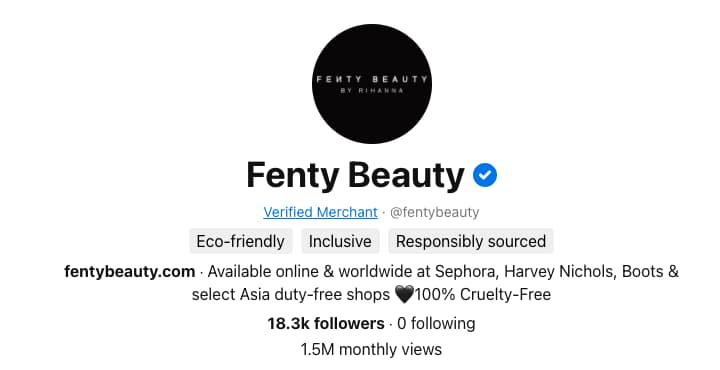



0 Comments